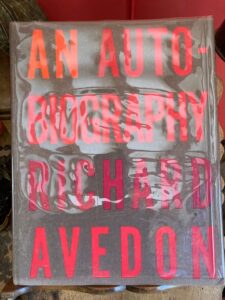 JC sent me a photo of a BOOK by Richard Avedon. This author illustrated his autobiography with his OWN photography. The book gives a peek into the creative genius of Richard Avedon, the great photographer. People interpret our world in many ways: visual, aural, kinetic, language based. The visual artist who thinks with his eyes sits high on my list of symbolic ways of thinking.
JC sent me a photo of a BOOK by Richard Avedon. This author illustrated his autobiography with his OWN photography. The book gives a peek into the creative genius of Richard Avedon, the great photographer. People interpret our world in many ways: visual, aural, kinetic, language based. The visual artist who thinks with his eyes sits high on my list of symbolic ways of thinking.
A few artists changed the way we think about our visual world, one of them Avedon. I met two former fashion models in Montecito that he photographed, and they showed me some of his images. Incredible!
The block-lettered title of JC’s An Autobiography by Richard Avedon takes up the whole cover. The fly leaf shows his signature and a date, and when I see it in person I’ll know if it’s hand applied.
Avedon and Baldwin Lasting Friendship
Around the age of 14-16 you learn HOW to understand your world, and sometimes you begin to WORK on that understanding. I remember at 13 tearing apart every room in my mother’s modest house to try to make it more ‘artistic,’ and I loved to write poetry. When at 13 I discovered my language was both written and visual, I found a direction. Likewise, Richard Avedon in his high school years discovered his visual GIFT. He joined forces with a friend good with written symbolic language, and formed the magazine THE MAGPIE for the Bronx school in the 1940s.
That friend was none other than the soon to become renowned author, James Baldwin (1923-1987). In later years, Avedon further collaborated with Baldwin, but not before they tried out their 14-16 year-old powers. Baldwin went on to write some of the best loved classics in modern literature: Go Tell it on the Mountain, Giovanni’s Room, The Fire Next Time, Notes of a Native Son, If Beale Street Could Talk, and Nothing Personal.
Well, he and Richard Avedon formed a friendship that lasted through the years.
And that is in the book JC owns. It tells the story of their collaboration, the story of Avedon’s life as an artist, with shots of Groucho, Chanel, Shrimpton, and everyone in between.
After high school Avedon went on to the photography department of the US Merchant Marine. From 1951-1965 he worked as staff photographer at Harper’s Bazaar, then Vogue from 1966-1988. He reunited with Baldwin on the publication of Nothing Personal the story of the early civil rights movement in 1964. In 1992 Avedon became the staff photographer at The New Yorker.
I can’t help myself—I must brag that in my younger career I worked with a ballet, and travelled to Milan where I met Nureyev. Of course I’ve always longed for the money to buy Richard Avedon’s photographic book about the dancer published in 1963.
Various publishers Picked Up Avedon’s Book
When you own a book by this level of photographer, value depends on the publisher. Various publishers picked it up. The HIGHEST values are paid for the signed limited first edition produced for Avedon’s show at the Whitney, a 1994 Retrospective of his career titled EVIDENCE. He signed only 160 of those. That special boxed set included a second book of photos of Jean Shrimpton and Jasper Johns (Paris 1970). Those came with a white embossed slip case signed by Avedon. These sell from $4,000 to $6,500, depending on condition. I bet sometimes they go for MORE.
The book I think JC asked about, in a glassine protective cover, appears coffee table sized. Taschen published a SUMO sized version at fifty by seventy inches, which sells for a couple of thousand, especially the Taschen’s first editions. The average price for the SUMO Taschen is $2,590.
If JC’s book measures fourteen by twelve it’s the first edition by Randall House NY 1993, and may sell in pristine shape for $1,800. The price declines based on condition to the bottom average condition at $300.
Not only is the book a treasure, but it marks a period in which the very visual among us collected books of photography. Perhaps illustrated books are a dying art, but like all dying arts, will resurrect like the Phoenix.